Arizona raising funds to build border fence with inmate labor
Posted by Elena del Valle on August 10, 2011
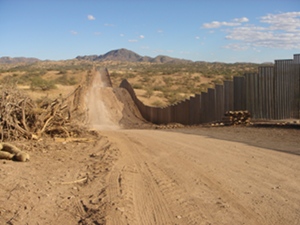
Border wall at Buenos Aires National Wildlife Refuge, Arizona
Photos: Matt Clark, Border Patrol, Gerald L. Nino, U.S. Fish and Wildlife Service, Tom Smylie, Miguel de la Cueva
There are 368 miles of border between the country of Mexico and the State of Arizona. The federal government has already built 306 miles of fence along that border, 123 miles of pedestrian fence and 183 miles of vehicle fence. Per the Secure Fence Act of 2005, the federal government has already completed almost all of 651 miles of border fencing that were planned.
This fencing doesn’t include 82 miles of open border in Arizona, according to Patdollard.com. At the same time almost one third of the 1,950 miles of U.S. Mexico border lie within military, tribal, and public lands such as wilderness areas, national wildlife refuges, national forests, national monuments, state parks and hundreds of miles of national park lands (see Border Legislation, http://www.defenders.org/programs_and_policy/policy_and_legislation/border_legislation.php).
The cost of building a border fence on the U.S.-Mexico border ranges between $1 million per mile at its most affordable to as much as $15 million per mile, according to the Government Accountability Office (see Arizona seeks donors for border fence, Bloomberg News).
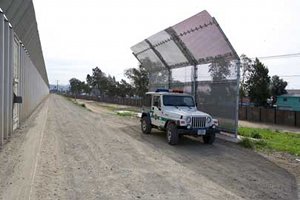
A Border Patrol agent sits next to an improvised fence seeking protection against rocks thrown from the Mexican side of the border
Feeling vulnerable by the three-hundred sixty-eight mile divide and fearing an “invasion” lawmakers in Arizona passed a law to raise as much as $50 million from private donors to build a border fence with inmate labor support. Build the Border Fence is the state’s fundraising campaign led by Senator Steve Smith and signed into law by Governor Janice K. Brewer with an effective date of July 20, 2011.
As of this writing, the campaign website hosted at Arizona’s Official Web Site, buildtheborderfence.com, lists 2,610 visitors and donations of $118,790. The website indicates that “The border fence constructed in Yuma, Arizona successfully thwarted 93 percent of all illegal crossings in that area. This proves that fences do in fact work!” It also states that “There have been over 35,000 deaths and murders along the U.S. Mexican border since 2006.” No sources for the data are included.
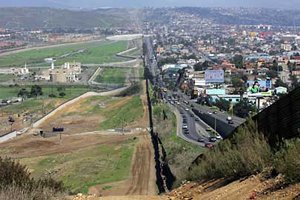
The U.S. Mexican border, Mexico is on the right side of the photo
There are two main sections that need fences in Arizona, Mathew Benson of the governor’s office explained by phone. A Yuma section which has proven to be effective and a Tucson section which only has vehicle barriers and needs reinforcement of “secure fencing” with an approximate cost of $3 million per mile. He was unaware of the number of miles of fence planned or the timeline for the project. He pointed out that the timeline would relate directly to the amount of money raised by the campaign.
“The word of people who live on the border,” Benson said when asked what information the state relied on to launch the campaign. “There is continued traffic of human traffickers and drug smugglers. It is a continuing issue. It is a difficult thing to get a figure for because it occurs in the shadows.”
The immigration numbers are down since the economy is down, he indicated. He also said that the number of illegal immigrants decreased in the Yuma section of the border since the federal government erected the fence.
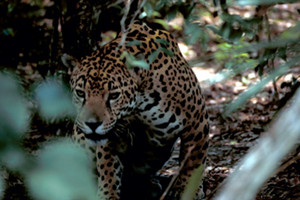
A jaguar, one of the species affected by the border fence
Some believe America’s southern border is safe and well guarded. A July 25, 2011 The Washington Post article concludes: “Like it or not, the border is a much safer and better monitored place than it has been in many years, and the trend lines promise more of the same (see Illegal immigration is way down and falling fast).” In addition to skepticism from those who believe the fence’s role in controlling illegal immigration is unproven and uncertain (see Noborderwall.com and Sierra Club Borderlands Campaign http://arizona.sierraclub.org/conservation/border/index.asp) there are those concerned about the environment. In Arizona, the Border Patrol estimated that 39 species protected or proposed to be protected under the Endangered Species Act are affected by its operations (see Wildlife and Border Policy, http://www.defenders.org/programs_and_policy/habitat_conservation/federal_lands/border_policy/index.php).
Defenders of Wildlife and the Sierra Club challenged the “short-sighted decision to build a wall through the San Pedro NCA, which is one of the American Southwest’s most unique and biologically diverse areas” in 2007. Defenders of Wildlife, dedicated to the protection of all native animals and plants in their natural communities, has more than 900,000 members and activists. The Sierra Club is one of America’s oldest, largest and most influential grassroots environmental organizations.

Matt Clark, southwest representative, Defenders of Wildlife
“The news is not good for wildlife. (There is) not only a loss of habitat but also wildlife fragmentation (disconnected pieces, wildlife corridors that were affected by the wall). I don’t think the state should be proud of this program because of the extensive damage that it will do to the environment and wildlife,” said Matt Clark, southwest representative, Defenders of Wildlife by phone. “At the end of the day it’s a lose lose for the environment. The state should use inmate labor to take down the damaging sections of the wall.”
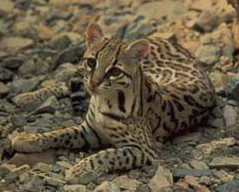
Mobility of ocelots in the fenced areas may be affected
Clark, coauthor of an article about the impact of the fence on area wildlife, explained that among the fauna affected are endangered and rare species like jaguars and ocelots (see Rare ocelot photographed near Sierra Vista, thrilling scientists by Tony Davis, Arizona Daily Star February 10, 2011) which have been sighted in Arizona as well as more common ones like mountain lions. He is concerned that by interrupting animal corridors and disrupting habitats the fence may affect genetic diversity and in the cases of rare animals with small populations lead to inbreeding (see United States border fence threatens wildlife by Melissa Gaskill).
“It’s a very good question and one we’re working on right now,” said Jose Viramontes, spokesperson, southwest region of the U.S. Fish and Wildlife Service by phone in response to a question about the impact of the federal fence on wildlife in the region and specifically in Arizona. “We actually are experiencing cross border migration among species that we know occupy the area. Fences in general are not good for wildlife.”










